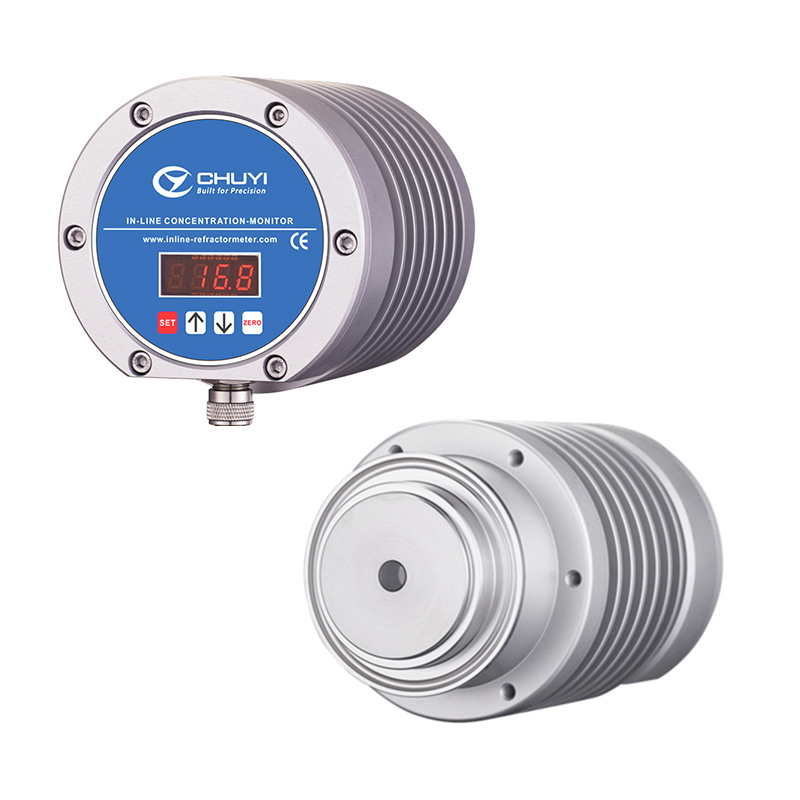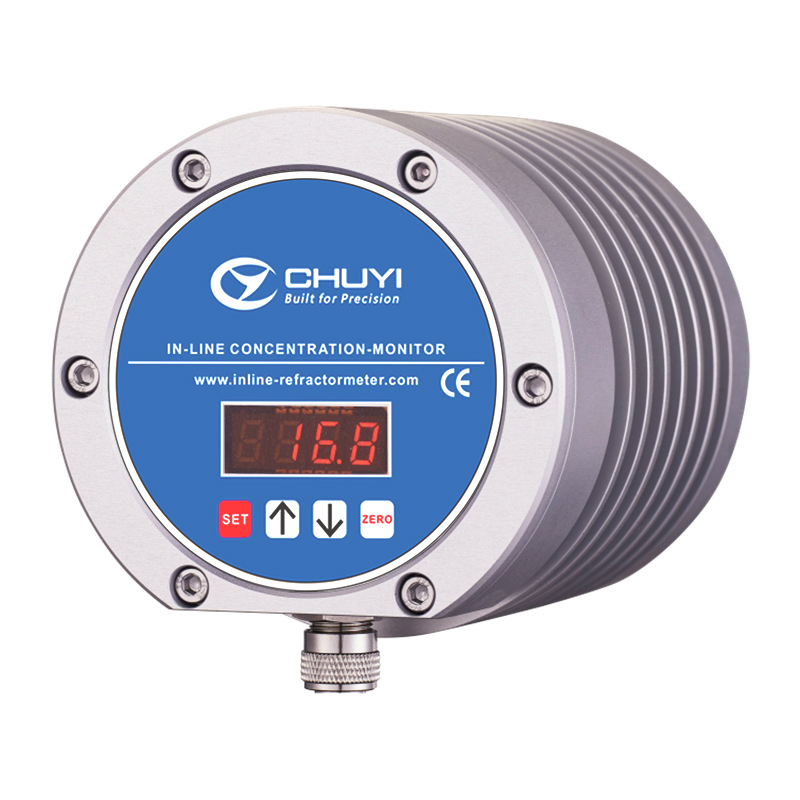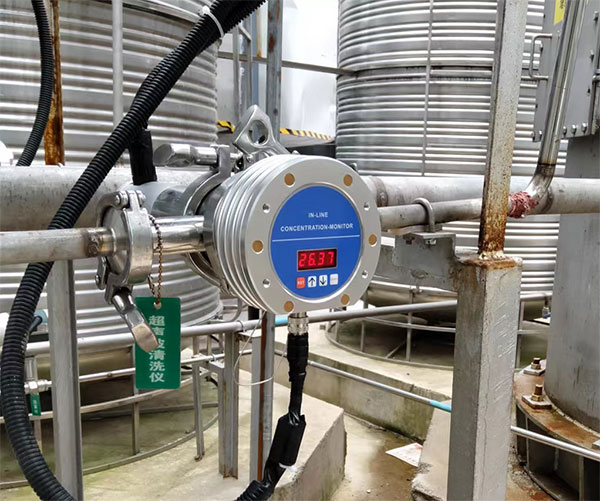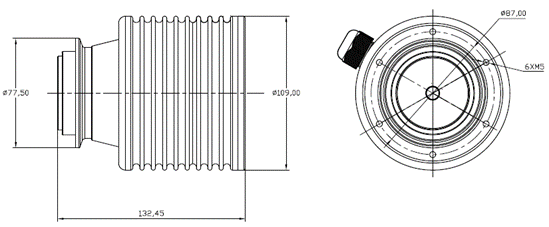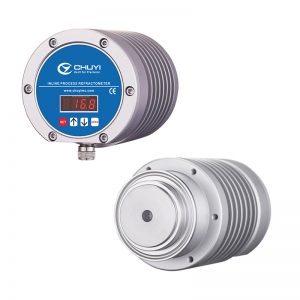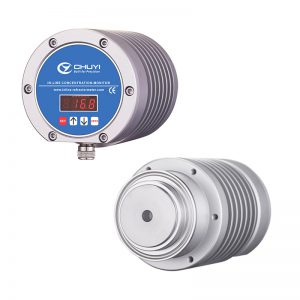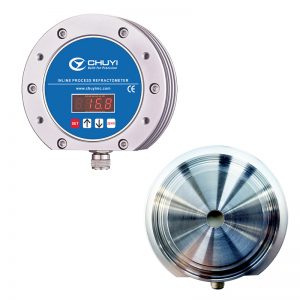Description
Specifications
| Product model | IPRM-G-NISO4 |
| Measurement item | Refractive Index (nD), Brix, ,temperature. |
| Measuring range | 0.00 – 35 .00% Brix |
| Resolution | 0.01% Brix |
| Measurement accuracy | ± 0.2% Brix |
| Brix range | Temperature corrected 5 – 60°C |
| Process temperature5 | -10°C up to +100°C |
| Prism | Sapphire |
| Wetted parts | Stainless Steel SUS 316L, optional: HastelloyC-276 |
| Power supply | 24 V DC |
| Interfaces | 1 output 4 – 20 mA,1 serial output RS485 |
| International Protection class | Display surface:IP65 Water resistant |
| Process pressure | Max. 1 MPa (145 psi, 10 bar) |
| Dimensions and weight | length 138 x diam.109mm; approx. 1870g |
| Cleaning components Options | IPRM-US, IPRM-Wiper |
| Fitting Options | IDF/ISO clamp union (1-3 inches), Flange, Compression Fitting G1/4 |
Dimensions
Measurement Principles
The refraction of light is a phenomenon wherein the direction that light is traveling changes as it passes through different mediums.
Through this phenomenon, we can observe as light’s direction changes and the “bent” appearance of substances even in the seemingly familiar, ordinary places in our day to day lives.
For example, imagine the lens of a pair of glasses and a pool.
When looking through the lens, an object appears larger or smaller than it is in reality.
When standing inside a pool, as you peer downward from the water’s surface, your legs will look shorter than they actually are.
As light moves from medium A (in this case, air) to medium B (lens and the pool’s water), it refracts.
Furthermore, it is known that light’s refraction changes depending on the concentration of a liquid.
The refractive index, which is a value that expresses the degree of refraction, is proportional to the density (mixture ratio) of a component.
Therefore, if there is 10g of sugar contained in 100ml of an aqueous solution and 20g of sugar contained in 100ml of an aqueous solution, the latter will have a higher refractive index value.
This difference in refractive index due to concentration variance has also been confirmed in solutions other than sucrose.
The properties of both the phenomenon known as the refraction of light and differing refractive index depending on concentration, are used as the principles of refractometers.
In addition to measuring the refractive index of a liquid, refractometers also display the concentration, converted from the refractive index.
Product introduction
IPRM-G-NISO4 inline refractometer meter is a high-precision, high-temperature resistant universal product launched by Chuyi Measurement and Control, which is suitable for online detection of various solution refractometers below 100 °C. The product integrates real-time refractometer measurement, digital tube display and signal output (including 4-20mA analog signal and RS485 digital signal output, with 2 switching control signal outputs). IPRM-G-NISO4 online refractometer meter is commonly found in pipeline bypass installation and small pipe diameter flow cell installation, other installation methods refer to the corresponding products, if there are explosion-proof requirements, please choose explosion-proof box products.
Product features
Nickel sulfate can also be used in the electroplating industry, as the main raw material for electroplating nickel and chemical nickel, and also the main raw material for the production of other nickel salts (such as nickel oxide, ammonium nickel sulfate, nickel carbonate, etc.). The printing and dyeing industry is used to produce phthalocyanine blue complexing agent, which can be used as a mordant for vat dyes. Catalyst for oxidation reactions in vitamin C in the pharmaceutical industry. In the production of hardened oils, it is the catalyst for the hydrogenation of oils and fats. In addition, it is also used in the production of nickel-cadmium batteries and the production of cemented carbide.
Product advantages
● It is not affected by the color, turbidity and viscosity of the material to be measured
● Not affected by bubbles, solid impurities and crystals in the material
● It is not affected by liquid pressure changes, flow changes, turbulent flow phenomena
● No mechanical action measurement, ensure stability and long life
● The detection prism is an optical grade sapphire prism, which is resistant to scratches, scratches and abrasion
● Detection of prism full-plane structure; No reagent consumables are required to run, and low power consumption
● With automatic temperature compensation function, the measurement accuracy is not affected by temperature
● Integrated measurement and display; Support panel and Bluetooth communication settings, view parameters
● 4-20mA/RS485; Built-in alarm, cleaning and switching signal output
● With 15 years of industry application experience, Chuyi Measurement and Control provides customers with the most complete product application solutions
● Chuyi Measurement and Control’s laboratory can provide data modeling and testing services for customers’ specific solutions
Application highlights
Based on the principle of light refraction, IPRM-G-NISO4 nickel sulfate refractometer inline analyzer is widely used in electroplating, nickel batteries, catalysts and other nickel salts, and is used in printing and dyeing mordants, metal colorants, etc.

